Food
What do these photos tell you about what food people ate?
Miners In Camp
This was a miners' camp in the mountains of Colorado. The men are eating a meal. Their campsite is littered with empty food cans.
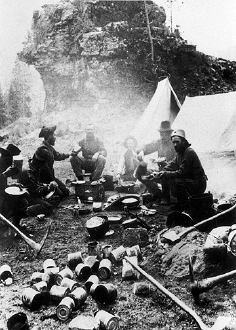
Photo: Colorado Historical Society
More About This Topic
The first gold-seekers to arrive in Colorado brought their food with them. There were no grocery stores or meat markets. They brought dried and preserved food that did not spoil. That included beans, flour, salt pork, dried beef and dried fruit. The men in the photo also had canned goods.
Their Own Words
"I stabled the team and went around to get the supplies. I had difficulty in getting all the machinery that Mr. Austin wanted, but we got some ox chains and dried beef, sardines, beans and coffee and several sides of salt pork. I did not have funds enough with me to get the sugar, molasses, cheese, crackers, dried fruit and other delicacies on his list--as the machinery and provisions have advanced in price above what he had calculated on paying."
Source: Diary of a unidentified young man, Central City, December 10, 1865; from The New Mexico Sentinel, July 3, 1938.
Cooking On a Campfire
The was taken in the Colorado mountains in 1874 by W. H. Jackson. It was taken at the campsite of a government survey team. Miners also cooked over campfires like this one. This is a "trick" photo. Can you tell why?
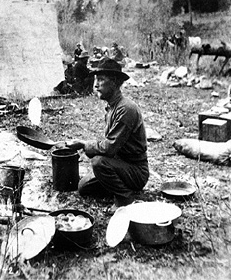
Photo: Colorado Historical Society
More About This Topic
This photo shows some of the cooking equipment used in mining camps. The man is holding a skillet in his hand. The pot on the lower left is a Dutch oven used to bake biscuits. The other pots were used for cooking stew and other dishes. The “trick” in the photo is the pancake being flipped in the air. It was drawn on the negative later. A camera shutter of the 1870s was not fast enough to capture a pancake in midair.
Their Own Words
[A gold rush breakfast]
"I, this morning tried my hand at baking 'Slap jacks' or pan cakes, the first bread I have undertaken to make, and I tell you that I had excellent cakes--light, clean and nice, and not a burnt one in the lot. They went first best with good butter and white sugar sprinkled over. The boys say I must 'do some more.' Won't I be just the handiest fellow when I get back to bake cakes for you? Brag on me a little can't you?"
Source: "The Letters of David F. Spain" (to his wife, Apr. 30, 1859) in John D. Morrison, ed., Colorado Magazine, 35 (April 1958): 103.
Three Miners In Their Cabin
This photo shows men sitting at a table in a mining cabin. They are playing cards. The dishes on the table indicate that they have just finished eating. A water kettle, skillet, and covered pot are sitting on top of the cook stove. A pan probably used for washing dishes is hanging on the wall.
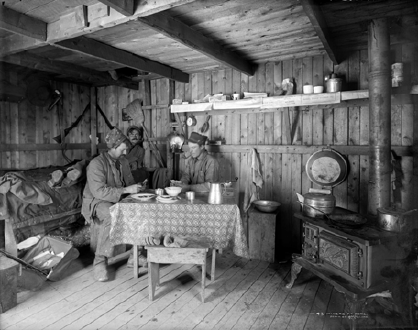
Photo: Denver Public Library, Western History Collection
More About This Topic
The first gold seekers lived in tents and cooked out-of-doors. In time they built log cabins or frame cabins like the one in this photo. Then they cooked indoors on an iron stove and ate at homemade tables and stools.
Their Own Words
[Supper in the Diggings]
"Yesterday John and I went a mile and a half up the creek to Doc Davenports Cabin. Spent the afternoon and ate supper with them, which consisted of Venison, Coffee, Rice & Stewed fruit. All hands had to use the same spoon and two or three the same knife and fork."
Source: " The Letters of David F. Spain," (to his wife, April 30, 1859), in John D. Morrison, ed., Colorado Magazine, 35 (April 1958): 106.
Two Miners In Their Cabin
The two men in this photo are sitting at a table in a log cabin. They have just finished a meal. The white bags hanging on the wall next to the rifle and suitcases probably contain food. Miners hung food and other supplies on the cabin walls to keep them out of reach of mice and rats.
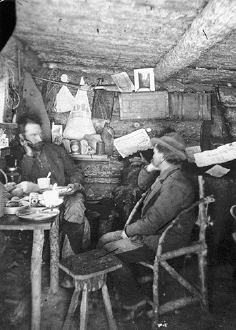
Photo: Colorado Historical Society
More About This Topic
Most of the early miners in Colorado were either single men or married men who came without their wives. Three or four men usually lived together in a cabin and cooked their own meals. Very few of the miners who came to Colorado were good cooks. They had little experience. Cooking was nearly always a woman's chore in the 1800s.
Their Own Words
“We are all well, and the Boys do say that I am getting fatter every day. I still do the cooking, and am getting to be quite adept in the art. I can Bake Bread good Enough for any body. Yesterday John and I went a mile and a half up the creek to Doc Davenports Cabin spent the afternoon and ate supper with them. Which consisted of Venison Coffee Rice and Stewed fruit. All hands had to use the same spoon and two or three the same knife and fork. They are not half as well fixed as we are. Doc says d—d if I aint ‘down on’ this HE cooking. I laughed at him and said wait till we get Home. Won’t we make the provender [the meals they would get at home] suffer.”
Source: David Spain letter to his wife Ella, “ The Letters of David Spain,” John D. Morrison, ed., Colorado Magazine, 35 (April 1958): 106-07.
Two Miners By Their Stove
This photo shows two miners sitting next to a stove in a log cabin. Their cabin had shelves for storing food. The men hung their skillets on the wall behind the stove.
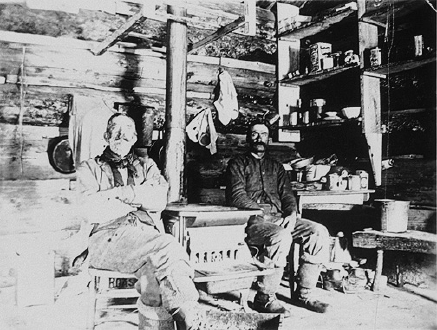
Photo: Colorado Historical Society
More About This Topic
Most of the food items on the shelves in this photo were canned goods. Canned food was very common in mining camps by the late 1800s. Nearly every kind of food was available in metal cans.
Their Own Words
"Maryland oysters shipped frozen in cans, canned salmon, chicken, and turkey which I kept on hand....
"We bought [canned] fruit, vegetables, and milk by the case. Occasionally two or three neighbors divided a case of something special to vary the monotony without investing too much. Canned food and eggs were allowed to freeze, but never potatoes or oil."
Source: Harriet Backus, Tomboy Bride, reprinted in Carl Ubbelohde, Maxine Benson, and Duane A. Smith, eds., A Colorado Reader (Boulder: Pruett Publishing Co., 1982): 98-99.

